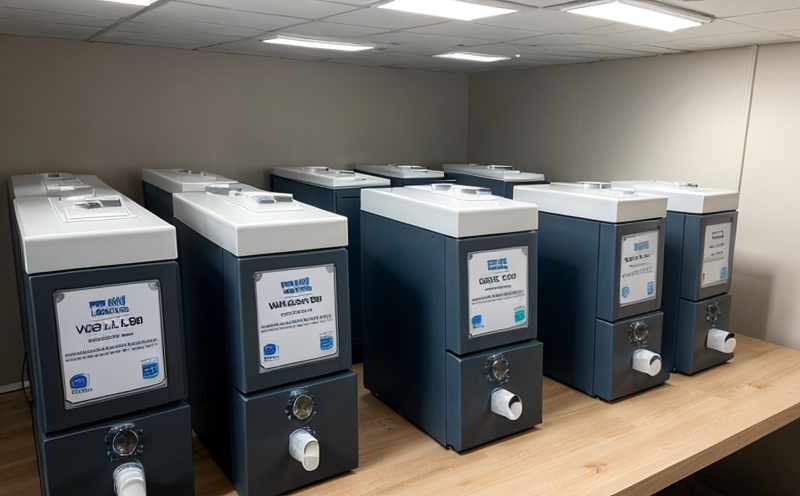CSA O160 Formaldehyde emission tests for wood based materials
The CSA O160 standard is specifically designed to measure formaldehyde emissions from wood-based products, including particleboards, medium-density fiberboards (MDF), oriented strand boards (OSB), and other similar materials. This testing protocol is crucial for ensuring compliance with international health and safety regulations.
The testing procedure outlined in CSA O160 involves placing the sample material into a climate-controlled chamber under standardized conditions of temperature and humidity. The formaldehyde gas released from the wood-based product during this process is then quantified using sensitive analytical instruments such as GC or TD-GC. Compliance with the maximum permissible emission levels is determined based on the results of these tests.
The importance of this testing cannot be overstated, especially in contexts where indoor air quality is a concern. Formaldehyde is known to cause irritation and adverse health effects when present at high concentrations. By adhering to the stringent requirements set forth by CSA O160, manufacturers can ensure that their products are safe for use in residential, commercial, and industrial settings.
The testing process also serves as a valuable tool for quality control during production processes. It allows companies to identify potential issues early on, thus minimizing waste and rework costs. Additionally, the results from these tests provide essential data for product design optimization and improvement of manufacturing techniques.
For those involved in research and development (R&D), CSA O160 offers an opportunity to innovate and develop new products that not only meet but exceed regulatory standards. This standard ensures that any modifications or improvements do not compromise the safety of end-users.
In terms of compliance, CSA O160 is widely recognized and accepted across North America as a means to ensure product safety and healthiness. Adherence to this standard helps companies navigate complex regulations more effectively while maintaining their reputation for producing high-quality products.
From the perspective of procurement professionals, selecting suppliers who comply with such stringent standards can help build long-term relationships based on trust and shared commitment towards maintaining high-quality standards.
Applied Standards
- CSA O160: This standard defines the procedure for determining formaldehyde emissions from wood-based materials.
- ISO 7892: Although not directly applicable, this international standard provides general guidelines on environmental testing which can complement CSA O160 when assessing overall product performance.
The application of these standards ensures that all tests conducted align with internationally recognized practices and methodologies. This consistency is vital for ensuring accurate results and reliable data.
Quality and Reliability Assurance
Ensuring the accuracy and reliability of formaldehyde emission test results requires rigorous quality control measures throughout every stage of testing. From precise sample preparation to calibration checks of analytical instruments, each step must adhere strictly to prescribed procedures.
The laboratory personnel responsible for conducting these tests undergo continuous training to stay updated with the latest techniques and best practices. Regular audits are conducted internally as well as externally by accredited bodies to verify adherence to quality assurance protocols.
Advanced instrumentation used in conjunction with trained technicians guarantees that even minute differences in formaldehyde levels can be detected accurately. This precision is particularly important given the stringent limits specified by CSA O160, which typically range between 5 and 20 parts per million depending on the type of wood-based material being tested.
Moreover, maintaining a clean and controlled environment within the testing chamber further enhances the reliability of the test results. Factors like temperature fluctuations or improper humidity levels could potentially skew the outcome, making it imperative to keep these variables constant during each test run.
The combination of advanced technology, experienced personnel, and strict adherence to established protocols ensures that all formaldehyde emission tests conducted meet the highest standards of accuracy and reliability.
Environmental and Sustainability Contributions
- Reduction in Indoor Air Pollution: By ensuring products emit minimal amounts of formaldehyde, laboratories following CSA O160 contribute significantly to improving indoor air quality.
- Sustainable Resource Management: The rigorous testing process encourages manufacturers to use sustainable resources and practices, thereby promoting better management of natural resources.
- Eco-Friendly Manufacturing Processes: Compliance with these stringent standards pushes companies towards adopting greener manufacturing methods that are less harmful to the environment.
The environmental benefits extend beyond just reducing formaldehyde emissions; they also encompass broader sustainability goals such as minimizing waste, conserving energy, and promoting recycling practices. By embracing CSA O160, laboratories play a pivotal role in fostering a more sustainable future.





